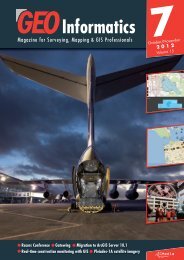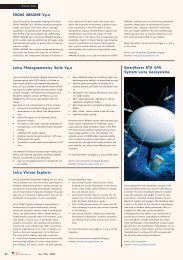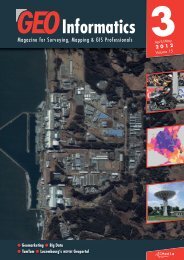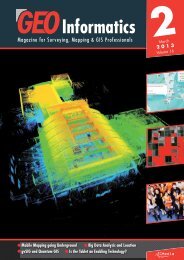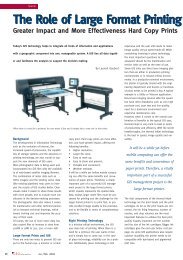2013 - Geoinformatics
2013 - Geoinformatics
2013 - Geoinformatics
Create successful ePaper yourself
Turn your PDF publications into a flip-book with our unique Google optimized e-Paper software.
16<br />
A r t i c l e<br />
EPA SWMM Interface of our network<br />
This offers the possibility of a global analysis of all of the activities, as<br />
well as a level of compliance with various regulatory aspects which<br />
can store all kinds of information.<br />
In this sense we can provide municipal inspectors with this tool for fieldwork,<br />
which will enable them to instantly analyze and edit information.<br />
Application in Urban Service Management<br />
There is no doubt that we are emerging from an era with a solid investment<br />
in new infrastructures, and that we are entering into another era<br />
where there will be a demand for optimal management of economic<br />
resources in order to maintain them. GIS will allow us to manage assets,<br />
through careful planning and analysis, monitor operations and enable<br />
their interaction with other technologies.<br />
For asset management, we will have to know what we have (inventory<br />
of each of the different elements). Once inventoried, we can plan and<br />
analyze; in this case performing multi-scenario analysis (levels of service,<br />
conservation, regulatory compliance, efficiency) in order to plan<br />
investments in operation and maintenance based on this analysis.<br />
We may also include monitoring operations with query interfaces and<br />
custom forms for this purpose, and finally make a documentary record<br />
of all events and actions that occur to the infrastructure, whether they<br />
interact or not with other technologies.<br />
Below, we can observe in detail how GIS can provide support in each<br />
of the different areas of urban service management.<br />
• Public roadway services<br />
With regard to public roadway services, a Management System of<br />
Urban Pavements can be found in gvSIG. Each of the elements that<br />
comprise this system, such as sidewalks or curbs, can be inventoried in<br />
pieces to later provide the user with a comprehensive and customized<br />
data model. This data model can have tables with characteristics, such<br />
as the dimensions, materials or geometries and also tables to store<br />
information that may evolve over time, such as the state of conservation<br />
or cleanliness, etc.<br />
All of this information will allow us to obtain an overview of the infrastructure<br />
to determine some service indexes of these services. These service<br />
indexes are based on all of the information of the pathologies<br />
gathered in the field, which will apply to evolution models. This makes<br />
planning conservation actions possible, with technical criteria, by optimizing<br />
the economic resources available for this purpose.<br />
Finally, it is also possible to have information on the degree of accessibility<br />
of the routes. This can be obtained by simply incorporating the<br />
necessary information, such as the minimum dimensions or elements<br />
which could limit such access into the data model when performing an<br />
inventory in the field.<br />
• Sewerage and Urban Drainage<br />
As for the infrastructure, our elements’ catalogue will be comprised of<br />
the major entities such as: wells, pipes, scuppers, water supply or singularities,<br />
as well as the elements necessary for mathematical modeling.<br />
Our topological construction will be carried out with the classical<br />
arc-node GIS that will provide us with a series of management facilities,<br />
including being able to use network extensions developed in gvSIG<br />
for any network analysis with this topology.<br />
For this purpose, using the 'connectivity' tool, we can analyze the sections<br />
of network to remain upstream or downstream from a given point<br />
and, in this way, plan various maintenance operations.<br />
Additionally, it would be useful if this infrastructure was connected with<br />
technologies for mathematical calculations of our network. In this specific<br />
case, this will be possible with gvSIG and EPA SWMM, as our<br />
team has specifically developed the INPcom communication extension<br />
that will allow for this.<br />
EPA SWMM is a calculating code developed by the U.S. E.P.A.,. The<br />
first version was released in 1971. One of its main advantages is being<br />
able to calculate up to an unlimited number of sections and to have a<br />
stable and robust code for hydrology, hydraulic or water quality. It<br />
does have a drawback, however, and this is that it does not have a<br />
GIS interface. With the developed extensions we can overcome this<br />
weakness, by combing both programs into a powerful tool for calculating<br />
and analyzing all types of sewerage and urban drainage.<br />
• Drinking Water Supply and non-consumption use<br />
The drinking water service supply can also be integrated into gvSIG,<br />
and as with the sewerage and urban drainage, we can outline our<br />
installation over the topographic base and communicate with EPANET<br />
code a program that is also USEPA, to analyze the networks of drinking<br />
water supply, provided that this exportation is also possible thanks<br />
to the INPcom extension.<br />
Based on Arc-node topology with which we will be working, all of the<br />
analysis potential of the gvSIG network extensions will also be operational<br />
for this service. Obviously the management of a drinking supply<br />
network can incorporate a lot of complicated technical technology<br />
depending on the information that you want to manage with it. It is<br />
important to mention that the tracking of operations can be carried out,<br />
such as communicating customer management software (CMS) with<br />
our database, which will give us access to the full potential of geographical<br />
management of such networks.<br />
Starting is easy<br />
The degree of complexity which can be achieved with this management<br />
system depends on the needs of the service be covered. The fact<br />
that we can carry out a scalable implementation, allows us to propose<br />
the first step, in which we only use a Geographic Information System<br />
(GIS) and to add technologies at a later date, as needs dictate.<br />
In this sense, after a GIS, we can consider implementing a relational<br />
database to connect field elements, publish maps, or connect with<br />
advanced management systems at a later date. We would like to make<br />
it clear that beginning is easy. It can be done at no cost, where the<br />
only investment is in education. Most importantly, we can get you started<br />
and we can do it now.<br />
Xavier Torret Requena, xtorret@tecnicsassociats.com.<br />
Josep Lluís Sala Sanguino, jlsala@tecnicsassociats.com,<br />
TECNICSASSOCIATS, ARQUITECTURA, ENGINYERIA I GIS<br />
Carlos López Quintanilla carlos.lopez@psig.es<br />
June <strong>2013</strong>





